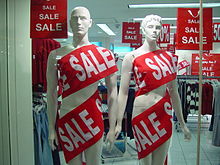Visual merchandising
Visual merchandising ( visual = visual, figurative, optical, visible. Merchandising = sales promotion, sales promotion, control of sales and distribution ) is the optical sales promotion in the sense of visual control of sales. Visual merchandising is a central tool in store brand management.
Definitions
The term "visual merchandising" has grown and shows a variety of focuses. One approach to a definition comes from Redler, who sees the coordinated presentation of the range, the services and the store itself as the core area of visual merchandising. According to Pegler as well as Diamond and Diamond, visual merchandising deals with the targeted representation and presentation of the company and its range of services in order to attract potential customers and to support the buyer's transaction activities as well as possible.
application
Visual merchandising is used at the PoS / PoP ( Point of Sale / Point of Purchase ) - i.e. always at the places where products, goods or services to be sold and potential customers actually meet. These meeting points of the sale (sale) or the purchase (purchase) are sales and presentation areas of all kinds, such as B. Shops, trade fairs, showrooms or events. In the meantime, virtual platforms, gastronomy and the real estate industry (with home staging) also access the know-how of visual merchandising.
Visual merchandising is also understood as an extension of marketing to sales. In the final analysis, visual merchandising ensures the stringent implementation of the marketing idea and strategy at the point of sale in visual terms. This includes all measures that are useful for sales promotion . This includes giving the customer a good and logical overview of the product, any supplementary products and the range. The products and merchandise images are placed and staged using visual stimuli that the customer is encouraged to buy.
Visual merchandising always keeps an overview of the holistic appearance of a point of sale or business and understands this as constant visual communication with the customer. This overview includes z. B. the external effect via the facade and shop window , customer stoppers and entrance area, the cleanliness and lighting outside and inside, meaningfulness and timeliness of the product structure and the decoration, local conditions and customer requirements, true to the original representation of a company and product to the outside.
The most important design parameters of visual merchandising include store layout, cleanliness, colors, light, product printing, product carriers, displays, shop fronts and shop windows. The store architecture also shows strong interactions.
Visual merchandising and online shop
While traditional visual merchandising refers to physical sales locations such as shops, the developing field of online visual merchandising (OVM) deals with the relevant design fields and effects of virtual sales environments.
literature
- Matthias Spanke, Sonja Löbbel: "Successful Visual Merchandising", Deutscher Fachverlag GmbH, ISBN 978-3-86641-257-6
- Mirco Hens: Visual Merchandising BBE Practical Guide to Problem Solutions for Commercial Entrepreneurs , BBE Verlag, ISBN 3-939563-53-6
- Birk, Fink, Geller, Lutz: Selling customer- oriented , Bildungsverlag EINS, ISBN 3-441-00612-7
- Mesher, Lynne. Shop design: goods perfectly staged. Munich: Stiebner, 2011, ISBN 978-3830714040
- Kreft, Wilhelm. Shop planning: merchandising architecture: design basics, experience staging, customer route planning. Leinfelden-Echterdingen: Alexander Koch, 2002, ISBN 978-3874226394
- Jörn Redler: Die Store Brand, SpringerGabler, 2018, ISBN 978-3-658-09708-0
Individual evidence
- ↑ Redler, J .: The Store Brand . Springer Gabler, Wiesbaden.
- ↑ Redler, Jörn: The Store Brand . SpringerGabler, Wiesbaden, p. 225 .
- ^ Pegler, M .: Visual Merchandising and Display . Fairchild, New York.
- ↑ Diamond, J., Diamond, E .: Contemporary Visual Merchandising and Environmental Design . Prentice Hall, Upper Saddle River.
- ↑ Redler, J .: The Store Brand . SpringerGabler, Wiesbaden, p. 226 ff .
